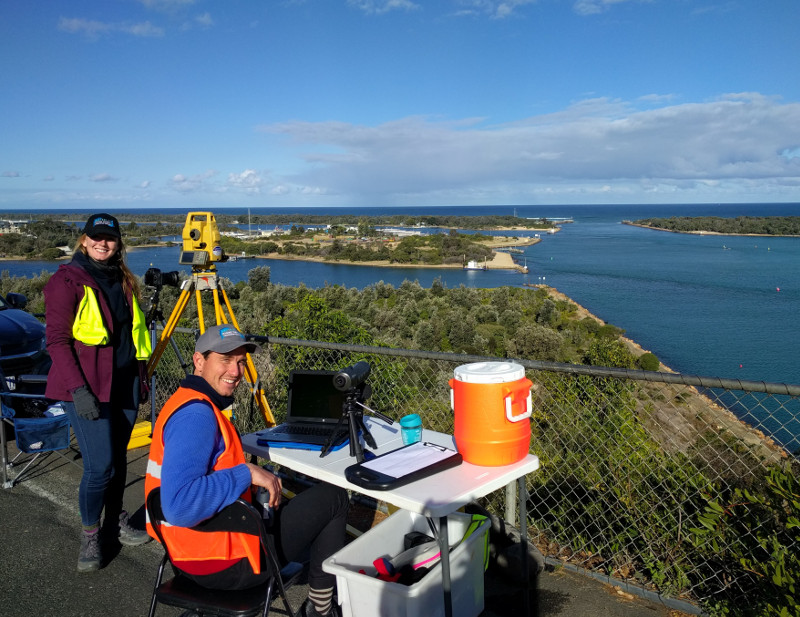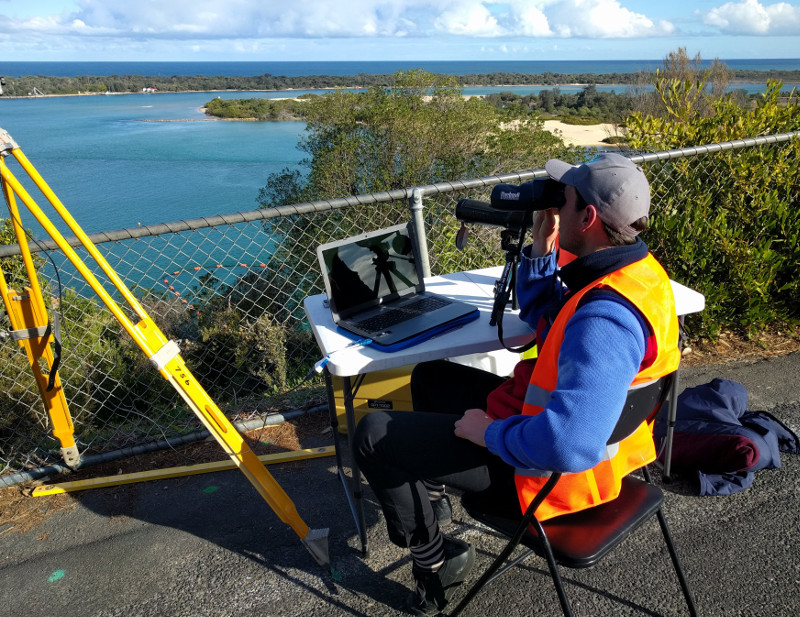


Project
Burrunan
Investigating our own endemic Lakes Entrance Dolphin Species
The other day I was very curious about a two young people with assorted gear sitting up at the Jemmy Point roadside lookouts on the road down the Kalimna hill and into Lakes Entrance. I did a u-turn at the roundabout over the bridge and headed back to quench my curiosity. I had heard they were tracking whales, which sounded very interesting.
Well I was only partly right as they were tracking pods of dolphins (well they are Cetaceans too) that are a localised population in the the Gippsland Lake System (not including the surrounding lakes like Lake Bunga or Lake Tyers). The scientific name of the Burrunan Dolphin is Tursiops australis. Using a combination of photography and telemetry they were identifying Dolphin activity in the main Reeves channel and the other arms and channels that open into that area. The Jemmy Point roadside lookout gave them a commanding view of where Cunninghame Arm, North Arm, Reeves Channel and The Barrier all feed into the main entrance channel. The organisation that was sponsoring this research was the Australian Marine Mammal Conservation Foundation.
These endearing, and very elegant, bottle nosed dolphins are loved by people all over the world. Check out these Google Images.
The scientists were very patient with my questions and added much extra useful information without prompting. I was very impressed with their professionalism and savvy community minded responses. Kate Charlton-Robb, a Cetacean researcher, has championed these Dolphins because it is believed they are genetically isolated from the other dolphin species and only found in port Phillip Bay and The Gippsland Lake System. This scientific paper will give you a glimpse of how much hard scientific work is required to establish a "new species". Because of the Burrunan's small populations it makes them more vulnerable to habitat change and we need to be careful, because if these populations die out, they cannot be simply replaced by importing dolphins from elsewhere (whether by human intervention or naturally). Who knows what adaptations these creatures have to survive here that other dolphins do not have?

The yellow tripod system was able to log pod and boat positions directly onto the laptop computer. The Nikon camera was used to film passing pods. The videos can be analysed later on to reliably identify individual dolphins by the shape of their dorsal fin. The system is also used to record the movement of boats as the dolphins are likely to interact with boats.

Binoculars and spotting scopes are used to scan the system for sightings and refine where the more exacting measurement systems need to be focused. The lap top was recording the measurements from the yellow tripod telemetry system directly into a mapping database. This allows immediate location of readings on a GPS style map.
The Australian Marine Mammal Conservation Foundation are a very worthwhile cause and you should consider visiting their website to get the full details about our local Dolphins.
The researchers will be back lake in January 2018 and we will try to catch up with them for an update on progress of the study.
Investigating our own endemic Lakes Entrance Dolphin Species
The other day I was very curious about a two young people with assorted gear sitting up at the Jemmy Point roadside lookouts on the road down the Kalimna hill and into Lakes Entrance. I did a u-turn at the roundabout over the bridge and headed back to quench my curiosity. I had heard they were tracking whales, which sounded very interesting.
Well I was only partly right as they were tracking pods of dolphins (well they are Cetaceans too) that are a localised population in the the Gippsland Lake System (not including the surrounding lakes like Lake Bunga or Lake Tyers). The scientific name of the Burrunan Dolphin is Tursiops australis. Using a combination of photography and telemetry they were identifying Dolphin activity in the main Reeves channel and the other arms and channels that open into that area. The Jemmy Point roadside lookout gave them a commanding view of where Cunninghame Arm, North Arm, Reeves Channel and The Barrier all feed into the main entrance channel. The organisation that was sponsoring this research was the Australian Marine Mammal Conservation Foundation.
These endearing, and very elegant, bottle nosed dolphins are loved by people all over the world. Check out these Google Images.
The scientists were very patient with my questions and added much extra useful information without prompting. I was very impressed with their professionalism and savvy community minded responses. Kate Charlton-Robb, a Cetacean researcher, has championed these Dolphins because it is believed they are genetically isolated from the other dolphin species and only found in port Phillip Bay and The Gippsland Lake System. This scientific paper will give you a glimpse of how much hard scientific work is required to establish a "new species". Because of the Burrunan's small populations it makes them more vulnerable to habitat change and we need to be careful, because if these populations die out, they cannot be simply replaced by importing dolphins from elsewhere (whether by human intervention or naturally). Who knows what adaptations these creatures have to survive here that other dolphins do not have?

The yellow tripod system was able to log pod and boat positions directly onto the laptop computer. The Nikon camera was used to film passing pods. The videos can be analysed later on to reliably identify individual dolphins by the shape of their dorsal fin. The system is also used to record the movement of boats as the dolphins are likely to interact with boats.

Binoculars and spotting scopes are used to scan the system for sightings and refine where the more exacting measurement systems need to be focused. The lap top was recording the measurements from the yellow tripod telemetry system directly into a mapping database. This allows immediate location of readings on a GPS style map.
The Australian Marine Mammal Conservation Foundation are a very worthwhile cause and you should consider visiting their website to get the full details about our local Dolphins.
The researchers will be back lake in January 2018 and we will try to catch up with them for an update on progress of the study.